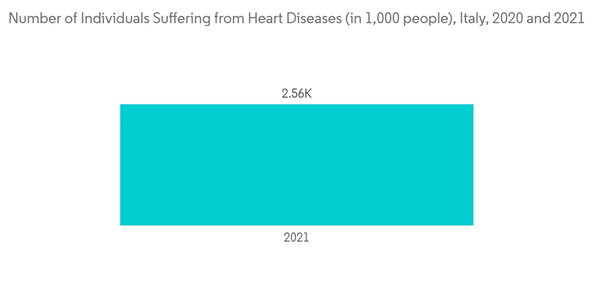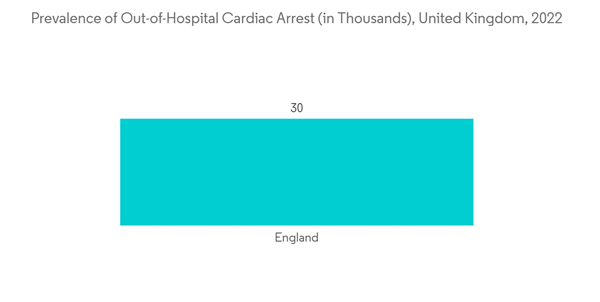The COVID-19 pandemic impacted the cardiac monitoring market significantly. There were fewer echocardiograms and other heart scans carried out during the pandemic, which means fewer people getting a diagnosis. The pandemic has also led to the delay of elective procedures due to COVID-19-related measures. For instance, British Heart Foundation (BHF) data updated in February 2021 found that there was a decrease in heart operations by 22% in England. Around 371,000 heart operations and procedures were performed in 2020, as compared to 2019 wherein more than 473,000 were carried out. Also, for non-urgent procedures, lifestyle changes, and medication were temporarily prescribed instead of cardiovascular procedures. Moreover, as per the study published in August 2021, by the National Library of Medicine, during the first wave of the COVID-19 pandemic, a marked decrease in hospital visits and admissions due to acute coronary syndromes, stroke, and heart failure decompensation was noted in Greece. Hence, this has resulted in a huge number of patients on the waiting list for cardiac surgery. For instance, as per December 2021 published article by the BHF, more than 275,000 people were waiting for heart tests and treatment, including heart surgery, at the end of September 2021 in England. This was 42,500 more people than in February 2020, before the pandemic. The number of people waiting over a year was 128 times higher than before the pandemic. Thus, to clear the backlogs of heart surgery in the region the market saw a surge. In addition, the market growth is stabilizing in the current scenario after COVID-19 as the disease screening services and surgeries have been resumed.
The key factors propelling the market growth are the growing incidences of cardiovascular diseases, advancements in technology, and the demand for home-based, point-of-care, and remote monitoring cardiac systems.
The increasing prevalence of cardiovascular disorders is one of the major factors driving the cardiac monitoring market. For instance, as per the BHF 2022 report, vascular dementia affected at least 150,000 people in the United Kingdom in 2022, and the number is predicted to rise to 350,000 by 2030. Hence, the high prevalence of cardiac diseases in European countries is anticipated to be the driving factor for the cardiac monitoring market.
Moreover, technological advancements in the field of cardiac monitoring are expected to boost the growth of the market over the forecast period. For instance, in September 2022, Huawei Consumer Business Group (CBG) announced that its latest smartwatch device, the HUAWEI WATCH GT 3 Pro and HUAWEI WATCH D, received CE certification for its HUAWEI ECG App. Similarly, in June 2021, MicroPort CRM announced the European launch of Alizea and Borea pacemakers after receiving the CE mark under the new Medical Device Regulation (MDR - 2017/745). The devices are equipped with Bluetooth1 technology for streamlined remote monitoring when paired with the SmartView Connect home monitor. Such advances are expected to boost the growth of the market over the forecast period.
Hence, with the increasing cases of cardiovascular diseases in the region, the market is anticipated to grow at a significant rate over the forecast period. However, the risk of infection due to implantable monitoring devices and unfavorable reimbursement policies are likely to restrain the market growth.
Europe Cardiac Monitoring Market Trends
ECG Monitor Segment is Expected to Dominate the Cardiac Monitoring Market During the Forecast Period
Electrocardiography is the process of producing an electrocardiogram, a recording of the heart's electrical activity. There has been an increase in the incidence of Cardiovascular Diseases (CVD), wherein long-term ECG monitoring is necessary. Moreover, with the introduction of wireless ECG, doctors can monitor and diagnose patients remotely on time, which further fuels the market. As a diagnostic tool, ECG has been around for a long time, and penetration of these systems in hospitals is very high. Despite its established nature, the market continues to evolve with new devices, including ECG monitoring systems at healthcare facilities; event monitors for subacute patient monitoring, which patients carry with them to record the heart rhythm for short periods; implantable loop recorders that are surgically inserted into patients and can record heart rhythms for an extended period; and telemetry and ECG data management solutions.Furthermore, the presence of advanced healthcare infrastructure and a continuous rise in the prevalence of cardiovascular cases in the European country is expected to boost the market. For instance, as per BHF 2022 report, in England, around 6.4 million people were living with heart and circulatory diseases in 2021. Thus, this increases the demand for cardiac monitoring devices, thereby driving the market's growth. Additionally, the presence of competitors, government initiatives, and cardiology awareness programs in the field of the external defibrillator segment is likely to boost the market growth. For instance, in July 2021, the European Commission's EU4Health program, Next Generation Recovery Funds, and Horizon Europe Research Funds provide an opportunity to further tackle the burden of CVDs and improve the cardiovascular health of citizens by implementing actions proposed in an EU Action Plan for Better Cardiovascular Health.
Considering the above-mentioned factors, the ECG Monitor segment is likely to witness growth during the forecast period.
United Kingdom is Likely to Witness a Growth in the Market During the Forecast Period
The United Kingdom is expected to have a significant market share in the cardiac monitoring market due to the developed healthcare infrastructure, government initiatives, and the rising burden of cardiovascular diseases. For instance, as per the BHF 2022 report, around 7.6 million people are living with heart and circulatory diseases in the United Kingdom. Also, around twice as many people live with heart and circulatory diseases in the United Kingdom than with cancer and Alzheimer's disease combined. Considering the high prevalence of cardiac diseases, the demand for cardiac monitoring devices is expected to increase in the country, which is anticipated to boost the market growth.Moreover, in August 2022, NHS England launched a new initiative, "@Home initiative," to support heart failure patients with the tools and expertise they need to remotely monitor their condition at home. The Managing Heart Failure Home initiative minimizes face-to-face appointments for these patients and reduces unavoidable hospital stays and readmissions. Such initiatives are expected to boost the market's growth in the country over the forecast period.
Europe Cardiac Monitoring Industry Overview
The Europe Cardiac Monitoring Market is fragmented and focused because of many large, medium, and small players. The multinational players possess a substantial share of the worldwide market. Companies like Abbott Laboratories, Medtronic, Boston Scientific Corporation, GE Healthcare, and Koninklijke Philips N.V., among others, hold a substantial market share.Additional Benefits:
- The market estimate (ME) sheet in Excel format
- 3 months of analyst support
This product will be delivered within 2 business days.
Table of Contents
Companies Mentioned (Partial List)
A selection of companies mentioned in this report includes, but is not limited to:
- Abbott Laboratories
- Medtronic Plc
- Boston Scientific Corporation
- GE Healthcare
- Koninklijke Philips N.V.
- Biotronik SE & Co KG
- Hill-Rom Holdings
- Schiller AG
- Biotelemetry
- Shenzhen Mindray Biomedical Electronics Co. Ltd
- Zoll Medical Corporation
- LivaNova Plc
Methodology

LOADING...










